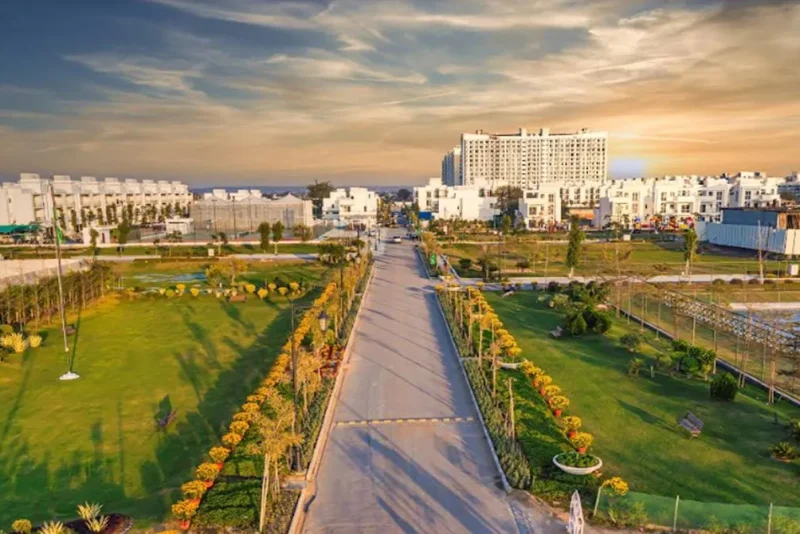The residential housing segment is witnessing a resurgence thanks to the pent-up demand for home ownership among first-time buyers against the backdrop of the Covid pandemic. But will the turnaround transform into a boom?
What a coincidence! Seasons come and go but spring this time has a special feel to it. A sense of “bahaar” — Urdu word for spring meaning rebirth, rejuvenation, renewal, a promise — pervades everything around us, the society, economy and what have you. And all this has to do with what we have gone through over the past year as a result of the Covid pandemic and how we have come out of it and staged an impressive recovery.
The feel-good factor is pervasive as company after company and sector after sector have reported a turnaround in their fortunes from the third quarter of the current fiscal. This has led experts to predict that India’s GDP may recover at a much faster clip than estimated earlier. The party on Dalal Street, too, has been on for quite some time now.
Take, for instance, the country’s real estate sector, which has been languishing for more than two years. Now, all eyes are on the residential housing segment, which has seen a turnaround of late. The sector’s importance can be gauged from the fact that the construction industry ranks third among the 14 major sectors in terms of direct, indirect and induced effects on all sectors of the economy.
Niranjan Hiranandani, National President, NAREDCO & Co-founder & MD, Hiranandani Group illustrates the sector’s importance saying, “The annual construction by the real estate sector stands at Rs 12.53 lakh crore which is 6.1 per cent of GDP of which developer housing contributes 42 per cent, self-construction constitutes 53 per cent and the rest is 5 per cent.”
The housing segment had been languishing for long due to a lack of new projects, poor sales, lakhs of unfinished projects, and poor delivery of homes across certain cities. The pandemic and the lockdown brought the entire sector to a virtual standstill.
But things are looking up and how. The GDP data for the third quarter of 2020-21, released by the National Statistical Office (NSO) on February 26, shows that the construction sector saw a growth of 6.2 per cent compared to a contraction of 1.3 per cent during the same quarter in the previous financial year.
Revival in steel consumption also reinforced acceleration in the construction sector, propping up employment as the economy unlocked. The housing market, a key consumer of steel, saw a gradual resurgence from the lows of Q1 of FY2020-21.
The power sector retained its momentum with consumption registering positive YoY growth since September 2020. October 2020 saw resilient credit flows to sectors such as construction, trade and hospitality — all closely linked to the real estate sector.
As per the latest Economic Survey (for 2020-21), the construction sector, which employs a large share of informal workers, had been severely affected by the pandemic-induced lockdowns. So was the housing sector where all construction activities came to a grinding halt for 4-5 months beginning March 25, 2020.
Numbers speak for themselves
Supply and sales of new homes showed a significant improvement in the last quarter of 2020 (Oct–Dec) in line with the ongoing economic recovery, with government initiatives and increased market confidence lending an added impetus.
“The last quarter of 2020 (Oct-Dec) saw housing sales of around 50,900 units in the top 7 cities. And, if similar sales trends continue into the next quarter or two, we can easily expect housing sales to fully recover by mid-2021,” says Anuj Puri, Chairman, Anarock Property Consultants.
Agrees Dhruv Agarwala, Group CEO, Housing, Makaan, and PropTiger. “The sector’s performance seems particularly impressive given that the pandemic has impacted the income-generating capacity of a large number of people. End-users and investors continue to feel confident about investing in real estate. Prices continued to remain stable and overall outlook looks positive,” says Agarwala.
Contrary to initial predictions, the residential segment was quick to see an uptick on the back of growing demand for home ownership amidst pandemic-like exigencies. This pent-up demand to own homes was further accelerated by the ongoing discounts and offers coupled with all-time low home loan interest rates.
we are seeing right now is organic demand driven by the desire to own homes. Even if and when the various discounts and offers are rolled back, demand is likely to remain,” says Puri. Anarock research reveals that housing sales in 2020 bottomed out and stood at 1,38,350 units in top 7 cities, rebounding to more than 53 per cent of the overall sales clocked in 2019 — approximately 2,61,500 units were sold in 2019 across the top 7 cities. This was much higher than Anarock’s previous predictions for 2020.
According to Real Insight Q4 2020, a quarterly analysis of India’s eight prime residential markets by real estate brokerage firm PropTiger, 54,329 new units were launched during the three months amidst the phased easing of restrictions put in place as part of one of the most severe lockdowns in the world to contain the spread of the corona virus. New launches grew by 173 per cent quarter on quarter (QoQ) to 19,865 units that were launched in the eight key markets during the July-September period. This also reflected a 12 per cent year-on-year (YoY) growth over the 48,530 new units that were launched in the December quarter of 2019.
This was the first quarter since the onset of the pandemic that witnessed a YoY growth signaling a turnaround in the market. However, only 122,426 units were launched in the entire 12-month period in 2020, about half the new supply in 2019 (244,256 units), the report says.
“While the trends point to a market recovery and positive news given the imminent launch of a vaccine that will ease the pandemic concerns, our optimism should be cautious. Buyers continue to expect low home loan rates, extension of developer offers and prefer ready-to-move inventory than those under construction,” says Mani Rangarajan, Group COO, Housing Makaan and P ropTiger.
Green shoots of recovery?
Another big positive for the housing market is that the realty firms, developers and specialist agencies have all been digitising at a rapid pace and more than 90 per cent of potential homebuyers have moved online to shortlist properties to buy. “We have seen a strong growth in online booking throughout 2020,” Rangarajan says.
And that is why the online real estate brokerage firm PropTiger has announced the launch of the online version of its ‘Right to Home 2021’ expo on 18-19 March 2021. The online expo will see more than 70 real estate developers showcasing a total of 19,000-plus housing units in various price segments, primarily falling in the range of Rs 45 lakh to Rs 4.5 crore, says the firm.
India’s leading real estate consulting firm CBRE South Asia, in its latest ‘Real Estate Market Outlook 2021 – India’ report, also highlights the recovery and growth across all segments including the residential housing segment.
“The government continues to lay emphasis on infrastructure development, incentivisation for affordable housing and initiatives which have been supporting RIETs, co-living and student housing in India also improving the overall investor sentiment. We expect to see significant growth across segments including office, retail, residential, among others,” Anshuman Magazine, Chairman & CEO, India, South East Asia, Middle East & Africa, CBRE, says.
As per CBRE’s report, the mid-end and affordable segments will continue to drive sales in 2021. Developer incentives and an enabling mortgage regime will boost the growth momentum of the residential sector with the millennials emerging as a key consumer class, the report says.
Reduction in circle rates in Delhi is another major step that is contributing to the positive sentiment in the residential housing market. “The move by the Delhi government to reduce circle rates by 20 per cent across all properties for a period of 6 months is bold and will certainly help in giving the necessary impetus,” Mudassir Zaidi, Executive Director – North, Knight Frank India said recently.
PNB Housing Finance and Yes Bank have also announced a strategic co-lending agreement to offer convenient and customised retail loans to homebuyers at competitive interest rates. They will jointly do due diligence and co-originate the loan at an agreed ratio.
Report from the ground
The top seven or eight housing markets are also the leading cities in the country. Whatever is the prevailing trends in these markets tend to rub-off on the surrounding localities. BW Businessworld went around taking stock from some of the leading housing developers on the ground situation.
What’s happening in the National Capital Region (NCR)? Kushagr Ansal, Director, Ansal Housing & President, Credai Haryana says: “Gurugram has the highest number of sales transactions in the city, with 6,065 units sold in the December quarter. During the quarter, Gurugram accounted for 57 per cent of the total revenue across NCR, while Noida and Greater Noida combined accounted for 28 per cent. The remainder of the demand was distributed between Ghaziabad and Faridabad.”
Amit Modi, Director, ABA Corp & President (Elect), Credai – Western UP says: “The market on the Yamuna Expressway and Greater Noida West has already benefited from the development around Jewar airport and the upcoming Film City.”
Mohit Goel, CEO, Omaxe, which operates in NCR and Punjab, says, “We have been seeing steady demand for homes in the state capitals and Tier-2/3 markets as well. For the real estate to be completely out of the woods, the low interest rate regime must continue over a long period of time.”
In Maharashtra and the Mumbai Metropolitan Region (MMR) too, the overall report is positive. Annuj Goel, Managing Director, Goel Ganga Developments says: “The recent real estate stimulus package unveiled by the Maharashtra government is expected to act as a booster dose for the property sector in the state.”
Nishant Deshmukh, MD, Sugee Group says: “We launched two projects during the lockdown, and both projects received good response from the homebuyers.”
Sanjeev Chandiramani, COO, Ruparel Realty says: “We sold 300 units amidst the lockdown. We will continue with our strategy of innovating and customising project configuration and will expand our slum rehabilitation development portfolio.”
Down south, Bengaluru has yet again emerged as a favourite investment destination, particularly for non-resident Indians looking to invest big moolah in the luxury segment. “The city also witnessed an absorption of close to 45-47 per cent in Q4 2020 versus Q3 2020 reflecting a steady recovery,” says Reeza Sebastian Karimpanal, President, Residential Business, Embassy Group.
The key takeaway, therefore is, that the housing market is on a rebound. Whether this turnaround will be long-lasting is hard to tell.
Source : Business World




